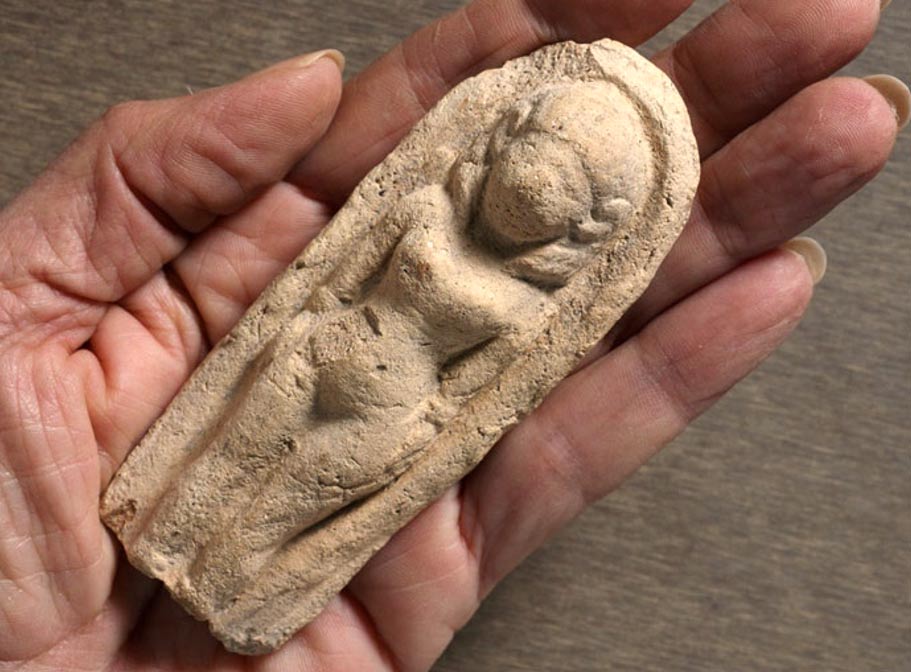Curious 3,400-Year-Old Canaanite Figurine Discovered by Young Boy in Israel
Beit She’an Valley is a National Park in northern Israel. It is also one of the most important excavation sites in a country which still hides many secrets. One of the more recent discoveries at the location was uncovered by a 7-year-old boy, who found a 3,400-year-old figurine.
According to Heritage Daily, the boy, named Ori Grinhot, was hiking in the area of the National Park with his friends and a father of one of them. When he stumbled across the statue on the Tel Rehov archaeological site, the stone shifted and the boy saw an image of a person covered with soil. He started to rub away the mud and found an ancient figurine. The rare clay figurine is a representation of a naked woman. It was made by pressing the soft clay material into a mold.
The boy showed his discovery to his companions and one of the adults called the Israel Antiquities Authority immediately. They brought the treasure to the office, where the IAA decided to award Ori with a certificate of good citizenship. He was also noted as the official discoverer of the figurine.

Ori Grinhot shows off the figurine he found. (CNN)
Since then, Ori Grinhot has become something of a local hero, and he received an award during a special ceremony at his school. His teacher, Esther Ladelle said, “Archaeologists came into the classroom during a Torah class, just as we had learned that [Biblical matriarch] Rachel had stolen the idols of her father Lavan.”
- Ancient Jewish necropolis in Israel given worldwide recognition
- Beit Guvrin, The Land of 1,000 Caves
- The Grail Cypher: A radical reassessment of Arthurian history
According to Amihai Mazar, professor emeritus at Hebrew University and head of archaeological excavations at Tel Rehov, the statue discovered by the boy is typical of the Canaanite culture dated to the period from the 15th to 13th centuries BC. Amihai Mazar told the Times of Israel:
“Some researchers believe that the figure depicted here is a flesh and blood woman, while others see it as Astarte, goddess of fertility, known from Canaanite and the Bible. There is a high probability that when the term ‘idol’ is mentioned in the Bible, it in fact refers to figurines such as this.”
For centuries, Beit She’an played an important role because of its location close to the Jordan River Valley and the Jezreel Valley. It was significant from the earliest known period of its existence until modern times.

Roman theater of Scythopolis, Beit She'an, Israel. (Tango7174/CC BY SA 4.0) Beit She’an was a significant site for many ancient civilizations.
In 1933, American archaeologist G.M. Fitzgerald from the University of Pennsylvania Museum started the first excavations. He dug on Tell el-Hisn, meaning ''castle hill''. Tell el-Hisn is a large mound, which allowed him to date the earliest settlement back in the Chalcolithic Period (some 5,000 to 6,000 years ago). The excavations proved that people also lived there during the Bronze age and after.
The American expedition discovered a large cemetery which was in use from the Bronze Age to Byzantine times. They also examined tombs discovered a little bit earlier, in 1926. According to the results of the research, the burials were dated as Canaanite graves made between 2000 and 1600 BC.

Beit She'an National Park. (benito roveran/CC BY 2.0)
In the 15th century BC, Beit She'an was conquered by the army of pharaoh Thutmose III. Egyptians changed the organization of the city, rebuilt the town and influenced the region with their own style and symbolism. During this period, a large Canaanite temple (39 meters (128 feet) in length) also appeared.
- Ten Amazing Caves of the Ancient World
- Ancient Ritual Bath Found in Jerusalem with Aramaic Graffiti on it
- A Paradise Lost: In Search of Eden
The artifacts discovered around the temple suggest that there was a mixture of Egyptian and Canaanite religious cults inside. Consistent with the hieroglyphic stele discovered in a temple, it was dedicated to the god Mekal. During the next three centuries, the Egyptians allowed the local people to adore their own god next to the Egyptian deities.
There are a few impressive monuments of Rameses II and steles of his father Seti I as well. The city was destroyed by fire around 1150 BC. Shortly after the destruction, around 1100 BC, the area of Beit She'an was conquered by the Philistines. They used it as a base for their army.

An ancient house of and Egyptian governor at Beit She'an. (Public Domain)
The term Canaanite is usually related to the Bible nowadays, which is largely due to the story of the Saul and David. In 1004, the Jewish king Saul lost a battle near the city. The Philistines who defeated him hung his body on the walls of Beit She'an.
King David wanted to punish the Philistines, so he conquered the city and also took the area of Ashkelon, Gath, Gaza, Ekron, and Ashdod. The town became a part of a huge kingdom, and was ruled by the biblical kings David and Solomon.
The name Canaan comes from the Hebrew language. It appears for the first time perhaps in the Amarna Letters from the 14th century BC. It was also found on Phoenician coins from the 1st century BC.
Featured Image: The 3,400-year-old figurine. Source: Clara Amit, Israel Antiquities Authority

















Comments
I am a retired teacher. I enjoy ancient info.